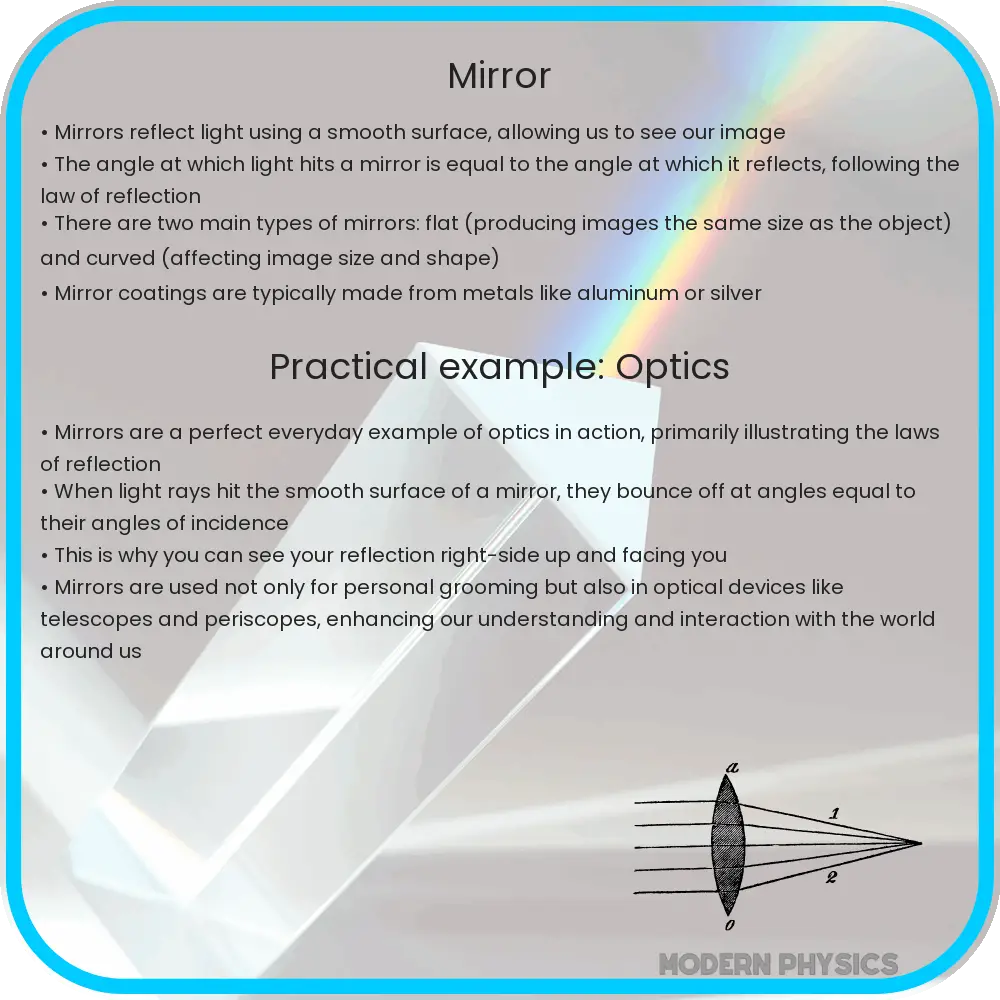Explore the precision, reflection quality, and design versatility of mirrors in geometrical optics and their impact on various technologies.

The Vital Role of Mirrors in Geometrical Optics
Mirrors, a fundamental element in geometrical optics, play a crucial role in various scientific, industrial, and artistic applications. Their ability to reflect light precisely according to the laws of reflection makes them indispensable in many optical systems. This article delves into the key advantages of mirrors, focusing on their precision, reflection properties, and design flexibility in the context of geometrical optics.
Precision in Light Reflection
One of the primary advantages of mirrors in geometrical optics is their unparalleled precision in reflecting light. Mirrors operate based on the principle that the angle of incidence (i) equals the angle of reflection (r). This principle ensures that light rays are reflected in a predictable and precise manner, which is vital for applications requiring high accuracy, such as telescopes, lasers, and periscopes.
Quality of Reflection
The quality of reflection offered by mirrors is another significant advantage. Mirrors can be designed to reflect nearly 100% of the light that hits their surface, a feature crucial in maximizing light efficiency in optical systems. This high reflectivity is particularly important in systems where light loss can significantly impact performance, such as in astronomical telescopes and high-precision scientific instruments.
Design Versatility in Geometrical Optics
Mirrors exhibit remarkable design versatility, adaptable to various shapes and sizes to meet specific optical requirements. From flat mirrors used in simple reflection tasks to complex curved mirrors employed in advanced optical systems, the adaptability of mirrors is a key factor in their widespread use. Curved mirrors, like concave and convex types, bring additional functionalities, such as focusing light to a point or dispersing light rays, enhancing the capabilities of optical devices.
Applications in Diverse Fields
The advantages of mirrors extend to a wide range of fields. In medical imaging, mirrors are integral in devices like endoscopes, providing critical internal views of the human body. In art and architecture, they are used to create illusions of space and light. The automotive industry relies on mirrors for safety in vehicles, and in scientific research, mirrors are pivotal in experiments involving light and its properties.
Overall, the precision, reflection quality, and design flexibility of mirrors make them a cornerstone in geometrical optics, enabling advancements and innovations across various disciplines.
Enhanced Optical Properties through Coatings
Mirrors can be enhanced with various coatings to tailor their optical properties for specific applications. Metallic coatings like aluminum, silver, or gold are commonly used for their high reflectivity in the visible and infrared spectrum. Dielectric coatings are also applied to improve reflectance, provide protection, and reduce light loss by absorption. These coatings are essential in achieving the desired performance in precision optical instruments.
Impact on Advanced Technologies
The integration of mirrors in advanced technologies cannot be overstated. In telecommunications, mirrors are vital in fiber optics and laser technology, guiding light signals with minimal loss. In space exploration, telescopic mirrors capture distant cosmic images, contributing to our understanding of the universe. Additionally, mirrors play a crucial role in the development of solar energy systems, where they concentrate sunlight to produce power efficiently.
Challenges and Future Developments
Despite their numerous advantages, the use of mirrors in geometrical optics is not without challenges. The precision in manufacturing, especially for curved mirrors, requires advanced technology and expertise. Additionally, mirrors must maintain their quality under various environmental conditions, which demands robust and durable designs. Future developments focus on creating lighter, more durable mirrors with even higher reflectivity, potentially using novel materials and nanotechnology.
Conclusion
In conclusion, mirrors hold a pivotal place in geometrical optics due to their precision, high-quality reflection, and versatile design. They are essential components in a multitude of applications, ranging from simple reflection tasks to complex scientific explorations. The advancement in mirror technology, including enhanced coatings and innovative manufacturing techniques, continues to expand their capabilities and applications. As we look to the future, the evolving design and improved optical properties of mirrors are set to play a key role in driving forward technological innovations and scientific discoveries, illuminating new possibilities in the realm of optics and beyond.
